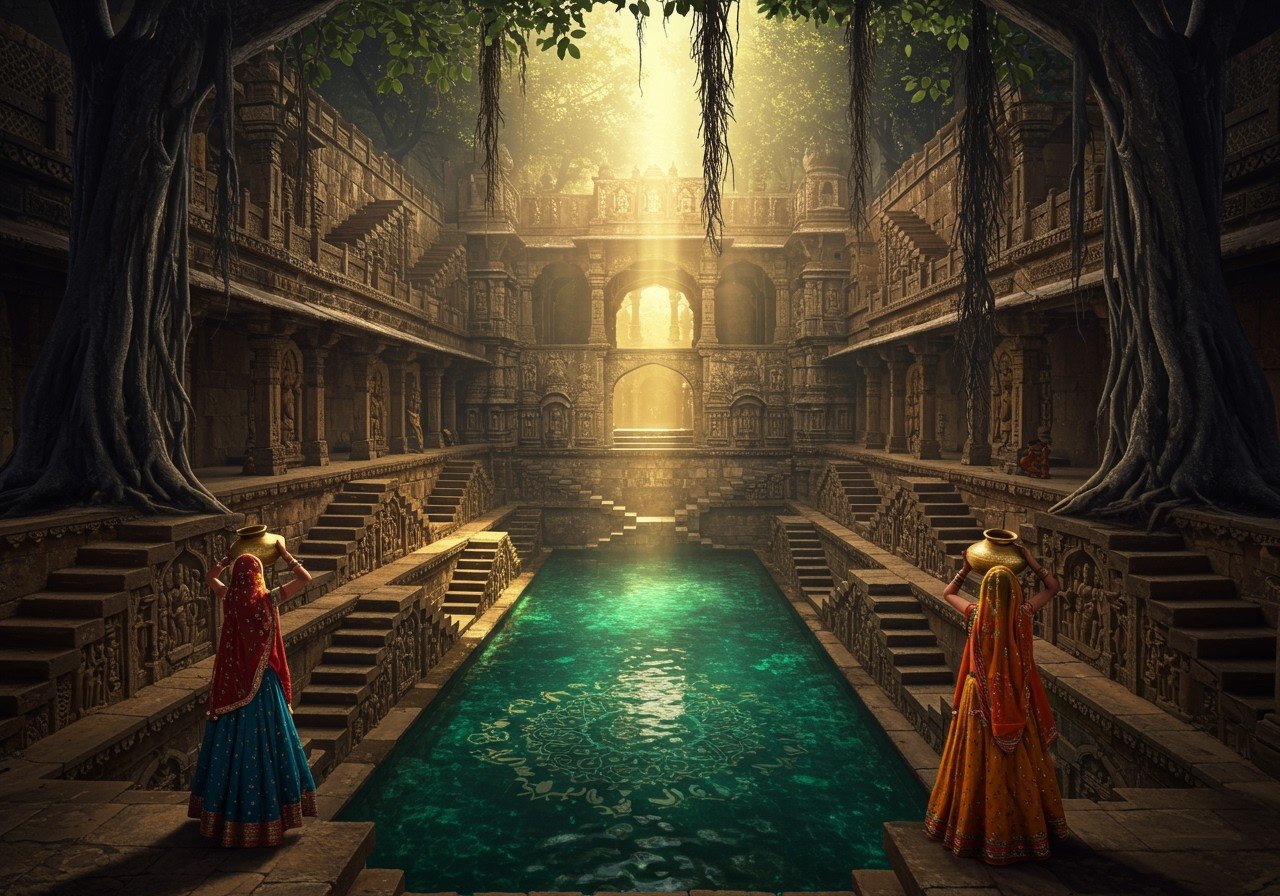
India, a land of ancient traditions and diverse cultures, boasts some of history’s most remarkable architectural wonders. Among these are the stepwells, ingeniously crafted structures that have served as vital water reservoirs for centuries. This article delves into the historical and architectural significance of India’s stepwells, illuminating their role in the country’s cultural and social fabric.
What is a Stepwell?
Stepwells, also known as ‘baolis’ or ‘vavs’, are essentially underground water storage systems featuring a series of steps descending to a central water source. Predominantly built in arid regions, these structures ensured a consistent water supply throughout the year. The intricate design and impressive engineering of stepwells made them both functional and aesthetically beautiful. They frequently served as venues for social, cultural, and religious gatherings, underscoring their significance in daily life.
Architectural Brilliance of Stepwells
The architecture of stepwells showcases the exceptional skill and creativity of ancient Indian builders. Key features include:
- Intricate Carvings: Many stepwells, such as the renowned Rani ki Vav in Gujarat, are adorned with elaborate sculptures and carvings depicting mythological scenes and deities, showcasing the artistic prowess of the time.
- Symmetry and Geometry: The remarkable symmetry and geometric precision evident in stepwells like Chand Baori in Rajasthan demonstrate advanced mathematical understanding and meticulous planning by the ancient builders.
- Multi-Storey Pavilions: Some stepwells boast multi-storey pavilions with ornate balconies and alcoves, providing shade and cool resting places for visitors, enhancing their functionality and comfort.
- Material Use: Stepwells were typically constructed using locally sourced stone, ensuring their durability and harmonious integration with the surrounding landscape, reflecting sustainable building practices.
- Engineering Marvels: The sheer depth and complexity of some stepwells, often extending over 100 feet deep, highlight the sophisticated water management techniques employed by ancient engineers.
- Architectural Styles: The architectural style of stepwells varies across different regions, reflecting local traditions and influences from various dynasties, showcasing the rich diversity of Indian architecture.
- Integration with Temples: Many stepwells are linked with temples, serving both practical and spiritual purposes, highlighting the interconnectedness of daily life and religious practices.
Historical Significance of Stepwells
Stepwells occupy a significant place in Indian history, dating back as far as 3500 years ago to the Indus Valley Civilization. They reached their zenith during the medieval period. More than 3,000 stepwells, mainly in Gujarat and Rajasthan, remain as historical and heritage sites.
- Ancient Origins: Early stepwells, while simpler, evolved into intricate architectural marvels, essential in water-scarce areas.
- Dynastic Patronage: Rulers’ funding led to diverse designs, each dynasty adding its unique touch to India’s architectural history.
- Sociocultural Hubs: Stepwells were not merely water sources; they were social hubs for interaction, festivals, and religious ceremonies.
- Women’s Role: Stepwells were important social spaces for women, providing opportunities for socializing and community building.
- Decline and Rediscovery: Modern water systems led to their decline, but they’ve been rediscovered and restored as heritage sites.
- UNESCO Recognition: Some, like Rani ki Vav, are UNESCO World Heritage Sites, underscoring their global importance.
- Preservation Efforts: Historians, archaeologists, and conservationists work to preserve these wonders for future generations.
Notable Stepwells Across India
- Rani ki Vav (Gujarat): Known for exquisite carvings and sculptures from the Solanki period.
- Chand Baori (Rajasthan): One of the deepest and largest, with 3,500 symmetrical steps.
- Agrasen ki Baoli (Delhi): A tranquil oasis in the bustling capital, showcasing ancient engineering.
- Adalaj Stepwell (Gujarat): Famous for intricate carvings and legends, blending Hindu and Islamic styles.
- Panna Meena ka Kund (Rajasthan): A beautifully symmetrical stepwell near Amber Fort in Jaipur.
- Hampi Stepwell (Karnataka): Showcases the grandeur of Vijayanagara architecture and engineering.
- Toorji ka Jhalra (Rajasthan): Recently restored and a popular attraction in Jodhpur.
Cultural and Social Impact
- Water Management: Played a vital role in water conservation in arid regions.
- Religious Significance: Often associated with religious rituals, serving as sites for worship and purification.
- Community Gathering: Served as common meeting places, fostering community bonds and cultural exchange.
- Artistic Inspiration: Their beauty has inspired artists, photographers, and filmmakers.
- Tourism: Restored stepwells attract tourists interested in history and architecture.
- Education and Research: Valuable resources for studying ancient engineering and social history.
- Heritage Conservation: Preserving them safeguards cultural heritage for future generations.
How Poojn.in Supports Your Connection to India’s Ancient Heritage
Poojn.in empowers you to connect with India’s architectural heritage through authentic puja items and ritual materials. As you explore these magnificent stepwells, consider enhancing your experience with items for water-related rituals from our platform:
- Pure copper kalash and lotas, traditionally used for water offerings. Find authentic copper items here.
- Brass and silver vessels for sacred water storage, ensuring the purity and sanctity of your rituals. Explore our collection.
Visit Poojn.in to discover a wide range of traditional puja items that deepen your connection to India’s rich water heritage. Our customer service team is ready to assist you.
Conclusion
India’s stepwells are more than just architectural marvels; they represent the country’s rich history, ingenuity, and cultural heritage. These structures have served various purposes, from water conservation to social gatherings and religious ceremonies. As we rediscover and restore these magnificent stepwells, we honor our ancestors’ craftsmanship. Preserving them is crucial for future generations to appreciate these historical treasures. Let us continue to celebrate and protect these remarkable symbols of India’s architectural and cultural legacy.


